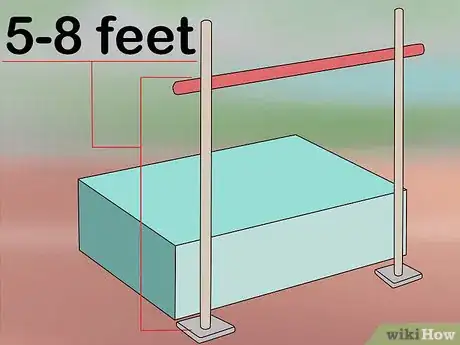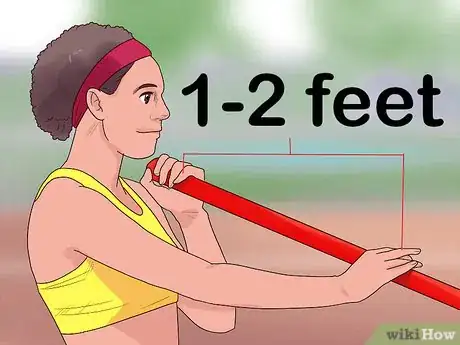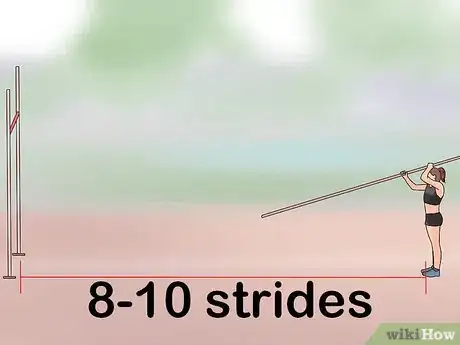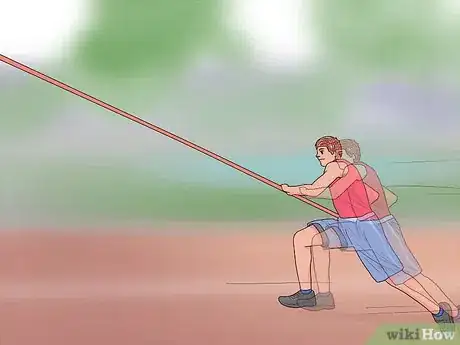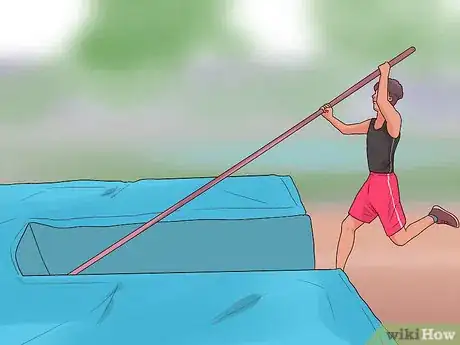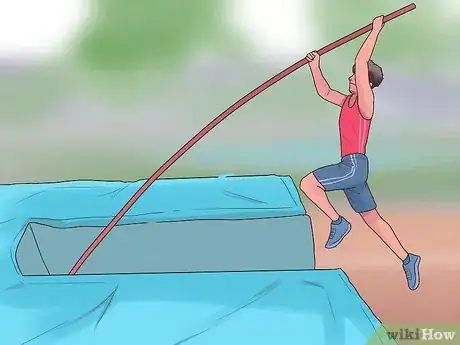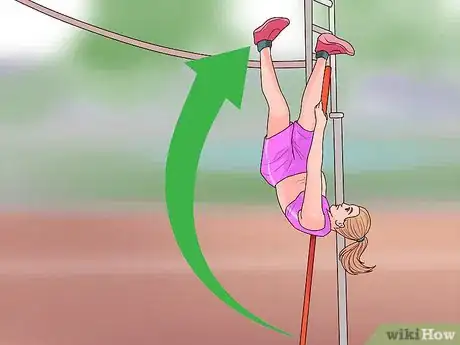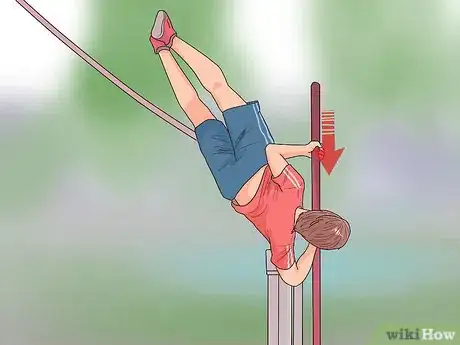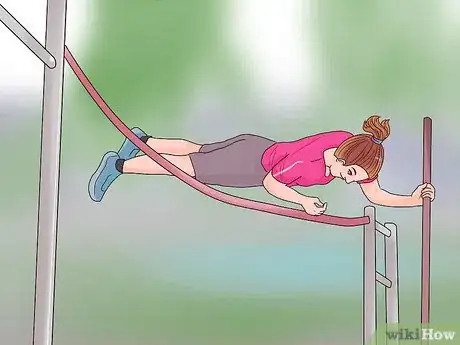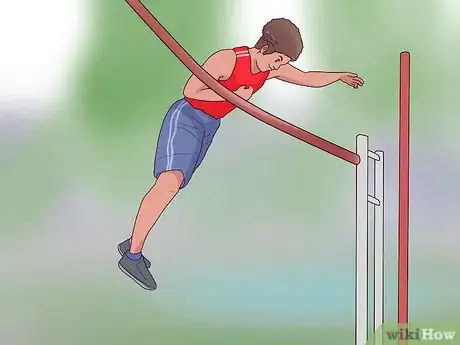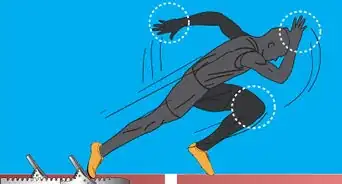This article was co-authored by wikiHow Staff. Our trained team of editors and researchers validate articles for accuracy and comprehensiveness. wikiHow's Content Management Team carefully monitors the work from our editorial staff to ensure that each article is backed by trusted research and meets our high quality standards.
This article has been viewed 207,712 times.
Learn more...
Pole vaulting is growing in popularity all over the world due to an increase in track and field programs. The sport requires a high level of bodily awareness, flexibility, and speed. To learn how to pole vault, you’ll need to get your body ready for the activity, purchase the right pole, and practice your technique.
Steps
Making Your Approach
-
1Select the height of the bar for your vault. For your first few vaults, you should remove the bar completely to give you the most space to learn the movements of vaulting. For your next few jumps, try using a bungee cord to approximate the feeling of a pole. Then, once you are confident with clearing the bungee at 5 to 8 feet (1.5 to 2.4 m), place the standards (the pole you jump over) at the same height. This bar will get progressively higher as you become more confident.[1]
- For most beginner vaulters, a good vault is 5 to 6 feet (1.5 to 1.8 m)[2]
- Many serious high school and college competitors can vault 13 to 17 feet (4.0 to 5.2 m)
- For Olympic competitors, vaults of 18 to 20 feet (5.5 to 6.1 m) are common
-
2Place your dominant hand high on the pole and the other slightly below. On your first attempt, place your dominant hand about a foot below the top of the pole. Place your other hand 1 to 2 feet (0.30 to 0.61 m) below that, depending on what is most comfortable for you.[3]
- Right-handed people will hold the pole with their right hand on top and their left hand below that.
- Left-handed people will hold the pole with their left hand on top and their right hand below that.
Advertisement -
3For your first vaults, position yourself 4-5 strides from the outer edge of the box. You can measure your strides by holding the pole and running (starting with your right foot) down the runway away from the pit. The number of times your left foot lands gives you your number of strides. When you find your position, turn to face the box.[4]
- Once you find a starting spot that feels comfortable, you should mark it with chalk and reuse this mark for your further runs.
- Once you are used to running this distance to the pit, you can scale your run back to 8-10 strides. The farther you run, the faster you’ll move and the higher you’ll be able to vault.
-
4Sprint toward the box with the pole over your shoulder or at your hip. The faster you run, the higher you’ll go, so try to run as fast as possible. It can be helpful to run in place before starting to improve your quickness.[5]
- It might take you a few tries to find the perfect starting point for your run. Don’t get discouraged if it feels uncomfortable the first few times.
Vaulting
-
1Plant the far end of your pole at the inner edge of the box as you approach. This is the most crucial point of your vault. For your first few runs, you should hold the pole above your head with your arms outstretched and be ready to place it directly in the center of the box, on the back edge.
- As you become more comfortable, you can rest the pole over your shoulder or hold it next to your waist, raising it above your head to plant it as you approach the box.
-
2Drive the knee of your dominant leg into the air. This is the beginning of your jumping motion as you are pushing off of the ground and using the pole as leverage while you pull on it. Your leg on the non-dominant side of your body will still be on the ground as you push up, with your toe pointed. This will give you lift and the pole will begin to bend.[6]
- Your lower arm should continue pushing on the pole to keep your body moving up and forward.
-
3Swing your non-dominant leg up in the air as the pole bends. The leg that was pointed will help your body move into an upside-down position. Keep pushing with your lower hand to get yourself as close to upside-down as possible.[7]
-
4Move your top arm in a pulling motion to give yourself additional height. Bring your dominant hand, which should still be toward the top of the pole, down to your hip in a pulling motion on the pole. Use your core muscles to keep your body moving and keep you close to the pole.[8]
-
5Turn your hips around the pole. Initiate the turn by turning your dominant foot to the inside. As you pull your body should naturally turn around the pole so that your belly is now facing the pit.[9]
-
6Push off of the pole when you are at your maximum height. At this point, you will be completely upside down. Try to keep your legs straight above your head while you push off of the pole. Let go of the pole as you feel yourself falling away from your maximum height.[10]
- Letting your legs fall down too quickly can take height off of your jump.
- Be careful not to let go too quickly, as you can fall headfirst into the box. It’s better to hold on for too long while you are learning, rather than risk an injury.
Landing Safely
-
1Twist your body so that your back is facing the mats. After you let go of the pole, you’ll begin falling to the mats. Your body should be in a position where you can safely turn as you are falling to land on your back.[11]
-
2Fall to the mats with your hands near your chest and legs slightly raised. Don’t try to catch yourself as you fall to the mats, as this can lead to broken bones. Make sure your arms and legs are out of the way as you fall.[12]
- Don’t try to land on your feet because this can cause ankle sprains or other serious injuries.
-
3Allow your back to take the impact of the fall. Most of the shock from the fall will be on your back, so try to be relaxed as you are falling and let the mats catch you. Being too stiff can cause back injuries, even when falling onto soft mats.[13]
Community Q&A
-
QuestionCan you start at age 9? Or am I too young?
 Community AnswerYou can start at age 3 according to the International Pole Vaulting League of Switzerland.
Community AnswerYou can start at age 3 according to the International Pole Vaulting League of Switzerland. -
QuestionCan someone get serious injuries while pole vaulting?
 Community AnswerYes. If you let go of the pole when you are planting into the box, it can come back to hit you, possibly with enough force to kill you. Also, missing the mat or landing on the crossbar could result in injuries.
Community AnswerYes. If you let go of the pole when you are planting into the box, it can come back to hit you, possibly with enough force to kill you. Also, missing the mat or landing on the crossbar could result in injuries. -
QuestionHow do I build strength for pole vaulting?
 Community AnswerDo lots of pull-ups, chin-ups, push-ups, ab exercises like planks and sit-ups, and practice your sprinting.
Community AnswerDo lots of pull-ups, chin-ups, push-ups, ab exercises like planks and sit-ups, and practice your sprinting.
Warnings
- Make sure you have someone to watch you while you are practicing in case of any injuries.⧼thumbs_response⧽
- Never vault with a pole that is lighter than you are.⧼thumbs_response⧽
References
- ↑ http://www.usatf.org/groups/coaches/library/2007/Pole%20Vault%20Training/2007NPEP-McGinnis.pdf
- ↑ https://www.wired.com/2012/08/jeff-hartwig-pole-vault/
- ↑ http://www.usatf.org/groups/coaches/library/2007/Pole%20Vault%20Training/2007NPEP-McGinnis.pdf
- ↑ https://www.wired.com /2012/08/jeff-hartwig-pole-vault/
- ↑ https://www.wired.com/2012/08/jeff-hartwig-pole-vault/
- ↑ http://www.usatf.org/groups/coaches/library/2007/Pole%20Vault%20Training/2007NPEP-McGinnis.pdf
- ↑ http://www.usatf.org/groups/coaches/library/2007/Pole%20Vault%20Training/2007NPEP-McGinnis.pdf
- ↑ http://www.usatf.org/groups/coaches/library/2007/Pole%20Vault%20Training/2007NPEP-McGinnis.pdf
- ↑ http://www.usatf.org/groups/coaches/library/2007/Pole%20Vault%20Training/2007NPEP-McGinnis.pdf
- ↑ http://www.usatf.org/groups/coaches/library/2007/Pole%20Vault%20Training/2007NPEP-McGinnis.pdf
- ↑ http://www.usatf.org/groups/coaches/library/2007/Pole%20Vault%20Training/2007NPEP-McGinnis.pdf
- ↑ http://www.usatf.org/groups/coaches/library/2007/Pole%20Vault%20Training/2007NPEP-McGinnis.pdf
- ↑ http://www.usatf.org/groups/coaches/library/2007/Pole%20Vault%20Training/2007NPEP-McGinnis.pdf
About This Article
To pole vault, start by sprinting toward the box with the pole over your shoulder or at your hip. As you approach the box, raise the pole above your head, then plant the far end of the pole at the inner edge of the box. At the same time, drive the knee of your dominant leg upward, then push off your non-dominant leg and swing it into the air as your pole bends. As you move into an upside down-position, rotate your hips so your belly is facing the pit. Finally, push off the pole and release it as you reach your maximum height and go over the bar. For tips on how to land your vault safely, keep reading!
